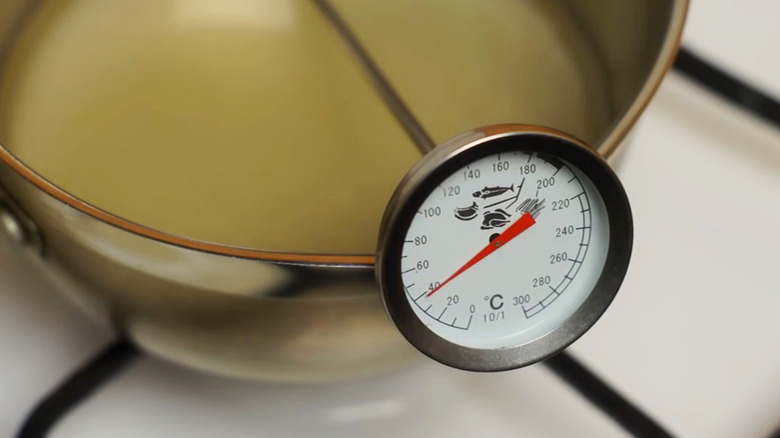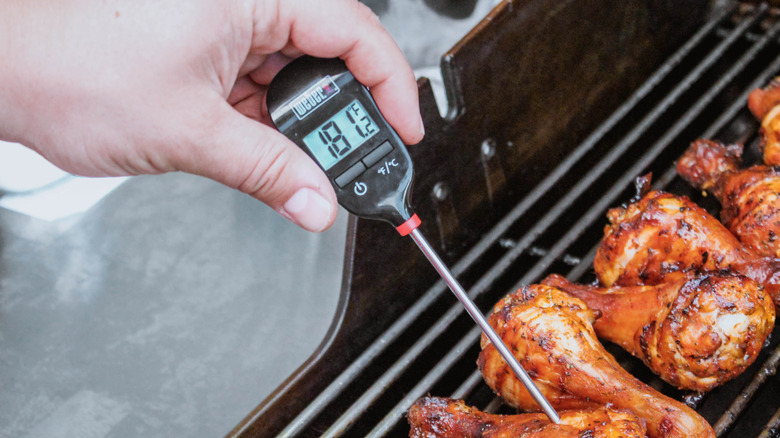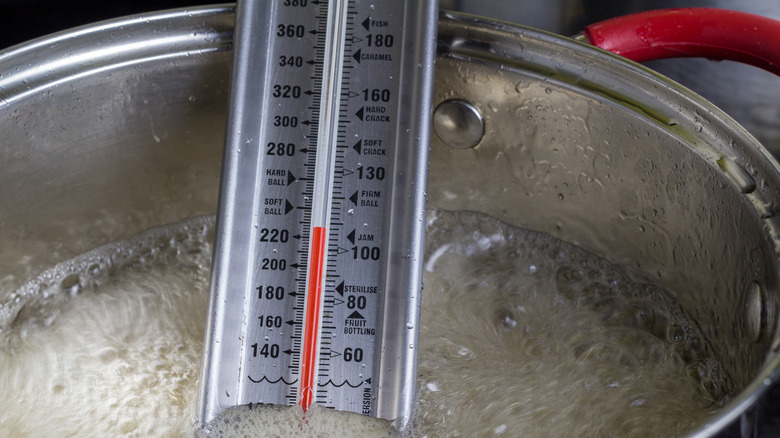Candy Vs. Meat Thermometer: What's The Difference?
In a world of sharp edges and open flames, it is impressive how much authority the humble thermometer wields in the kitchen. It never fails to evoke a sense of import, as everyone in the room internally acknowledges: "We're bringing out the science equipment. This just got serious." Temperature is an essential benchmark for assessing various foods, particularly meat and candy. The United States Department of Agriculture (USDA) has established strict guidelines for safely cooking meat to avoid foodborne illnesses. Similarly, Masterclass explains that the different stages of candy are delineated by their temperature at the peak of the cooking process.
Since precise temperature gauging is essential for cooking both meats and candies, any serious home cook would be advised to invest in a thermometer, or rather, a pair of thermometers. Many thrifty minds have thought to purchase just a meat thermometer or candy thermometer and use one tool for both purposes. Unfortunately, you can't kill two birds with one stone here because candy and meat thermometers are each highly specialized.
Candy and meat thermometers have different shapes
One major difference between meat thermometers and their candy-calibrating counterparts is apparent at first sight. As Masterclass explains, candy thermometers are quite long, designed so that you can safely dip the end into a boiling pot of peanut brittle, for example, while keeping your fingers out of harm's way. Their shape makes them useful tools for measuring any boiling liquid, be it syrup, sauce, or oil, which is why, according to Masterclass, they are also known as deep-fry thermometers.
Meat thermometers are the shorter of the two varieties. Instead of having a rounded end like candy thermometers, they have a pointed tip that is just sharp enough to pierce a roast and obtain the internal temperature of the meat to ensure it has reached the USDA threshold. Using a thermometer is the best way to check your meat without losing flavor, which will happen if you cut it open too soon.
Candy thermometers have a higher heat range
In addition to size and shape, the most important difference between meat and candy thermometers is their range. According to Masterclass, meat thermometers typically top out around 200 degrees Fahrenheit (93.33 degrees Celsius). This is still a generous threshold, considering that the highest cooking temperature for meat is a minimum of 165 degrees Fahrenheit minimum for poultry (per the USDA). Candy thermometers, on the other hand, typically measure up to 400 degrees Fahrenheit (204.44 degrees Celsius).
Making candy, such as caramel, begins by boiling sugar and water to make a syrup. Since water does not boil until 212 degrees Fahrenheit (100 degrees Celsius), per Pew Research Center, a meat thermometer topping out at 200 degrees would not even meet the minimum requirement for the job. Masterclass goes on to explain that candy goes through six stages as it cooks: the thread stage (230-234 degrees Fahrenheit) is the texture of syrup, the soft-ball stage (234-241 degrees) is the texture of fondant, the firm stage (242-248 degrees) is for caramels, the hard-ball stage (250-266 degrees) is for gummies, the soft-crack stage (270-289 degrees) is for saltwater taffy, and the hard-crack stage (295-309 degrees) is for brittles and glazes. None of these ranges could be accurately measured with anything but a candy thermometer.


